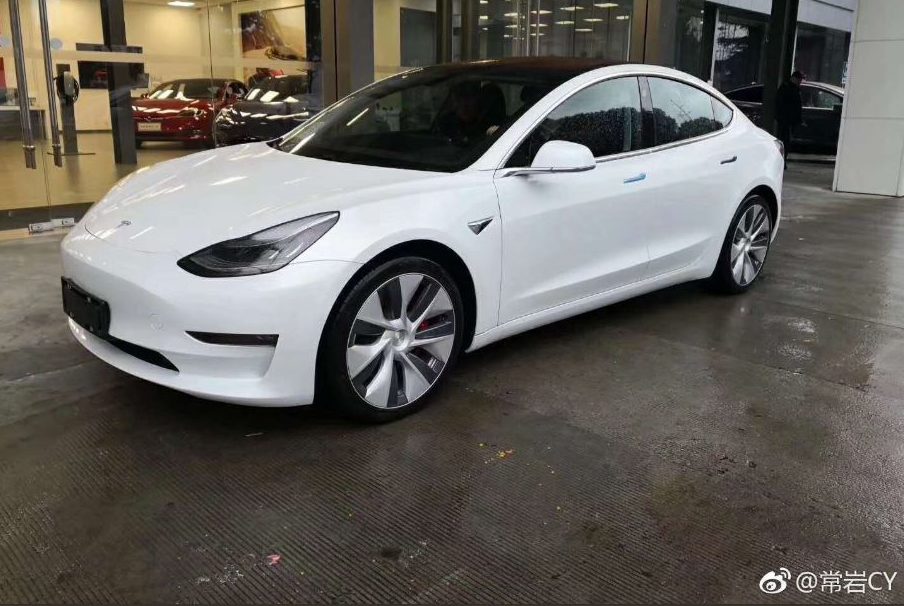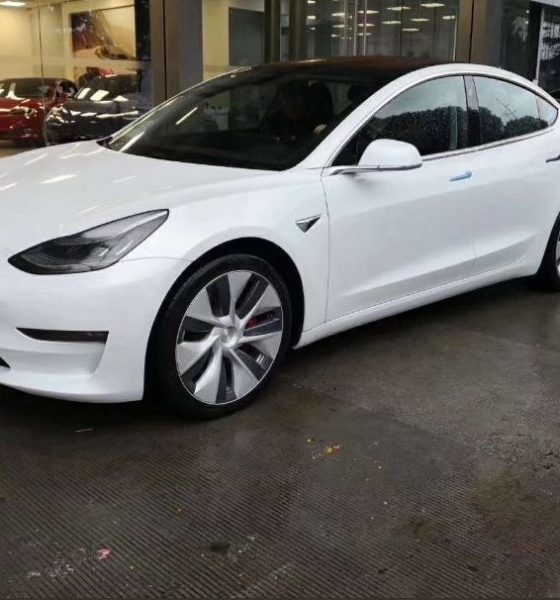

News
Tesla is charming Chinese customers with the Model 3’s excellent efficiency
Tesla Model 3 owners in China are taking to local social media platforms to express their appreciation of their electric cars. While China is already saturated with electric vehicles from local manufacturers, customers are noticing that Teslas are a cut above the average EV not only in design and performance, but in metrics such as battery consumption as well.
Tesla owner-enthusiast and Model S/X owner @ray4tesla recently shared some of these posts from Chinese social media. One Tesla owner remarked that his Model 3, which is a Long Range RWD variant, has been showing an average consumption of 14 kwh/100 km (225.31 Wh/mi). These figures were far superior to the usual consumption of competitors, which average 20 kwh/100 km (321.87 Wh/mi) or more.
It could be said that battery efficiency is one of the concepts that Tesla has mastered over the years. Faced with more electric vehicles from competitors today, the superiority of Teslas in battery consumption is difficult to argue. During a highway test between the Tesla Model X and the Jaguar I-PACE last year, for example, reviewers from nextmove in Germany were quite astonished to see a large gap in efficiency between the two SUVs. The company found that the I-PACE’s consumption averaged 22.5 kWh/100 km (362 Wh/mi) at speeds between 93 km/h (58 mph) and 110 km/h (68 mph), far higher than the larger and heavier Tesla Model X’s 17.5 kWh/100 km (282 Wh/mi).
Tesla also showcased its pedigree in efficiency in its recent refresh of the Model S and Model X. Both vehicles’ Long Range versions retained their 100 kWh battery pack after the update, but the cars showed a ~10% improvement in range. A test of the refreshed Model S by MotorTrend hinted that the electric sedan might be capable of achieving 400 miles of range per charge. That’s comparable to the range of Rivian’s top-tier R1S and R1T, and those trucks are equipped with a 180 kWh pack.
China’s fondness for the Tesla Model 3 appears to be increasing by the month. Since deliveries of the vehicle started in the first quarter, Chinese customers have given the Model 3 a warm welcome. The reception is not surprising, considering that the electric sedan is pretty much the best bang-for-your-buck Tesla in the country today. The Model 3 Performance is particularly compelling for buyers as well, thanks to its competitive price against rivals like the BMW M3.
What is rather interesting is that Tesla’s Model 3 push into China is only in its initial stages. Gigafactory 3, which is under construction in Shanghai, is designed to produce affordable versions of the Model 3 sedan and the Model Y SUV once it is operational. The facility’s buildout has been incredibly quick, with the factory shell of the project’s Phase 1 area now coming into form. Barring any unexpected delays, estimates point to Model 3 production trial runs to begin as early as September.

News
Tesla starts showing how FSD will change lives in Europe
Local officials tested the system on narrow country roads and were impressed by FSD’s smooth, human-like driving, with some calling the service a game-changer for everyday life in areas that are far from urban centers.

Tesla has launched Europe’s first public shuttle service using Full Self-Driving (Supervised) in the rural Eifelkreis Bitburg-Prüm region of Germany, demonstrating how the technology can restore independence and mobility for people who struggle with limited transport options.
Local officials tested the system on narrow country roads and were impressed by FSD’s smooth, human-like driving, with some calling the service a game-changer for everyday life in areas that are far from urban centers.
Officials see real impact on rural residents
Arzfeld Mayor Johannes Kuhl and District Administrator Andreas Kruppert personally tested the Tesla shuttle service. This allowed them to see just how well FSD navigated winding lanes and rural roads confidently. Kruppert said, “Autonomous driving sounds like science fiction to many, but we simply see here that it works totally well in rural regions too.” Kuhl, for his part, also noted that FSD “feels like a very experienced driver.”
The pilot complements the area’s “Citizen Bus” program, which provides on-demand rides for elderly residents who can no longer drive themselves. Tesla Europe shared a video of a demonstration of the service, highlighting how FSD gives people their freedom back, even in places where public transport is not as prevalent.
What the Ministry for Economic Affairs and Transport says
Rhineland-Palatinate’s Minister Daniela Schmitt supported the project, praising the collaboration that made this “first of its kind in Europe” possible. As per the ministry, the rural rollout for the service shows FSD’s potential beyond major cities, and it delivers tangible benefits like grocery runs, doctor visits, and social connections for isolated residents.
“Reliable and flexible mobility is especially vital in rural areas. With the launch of a shuttle service using self-driving vehicles (FSD supervised) by Tesla in the Eifelkreis Bitburg-Prüm, an innovative pilot project is now getting underway that complements local community bus services. It is the first project of its kind in Europe.
“The result is a real gain for rural mobility: greater accessibility, more flexibility and tangible benefits for everyday life. A strong signal for innovation, cooperation and future-oriented mobility beyond urban centers,” the ministry wrote in a LinkedIn post.
News
Tesla China quietly posts Robotaxi-related job listing
Tesla China is currently seeking a Low Voltage Electrical Engineer to work on circuit board design for the company’s autonomous vehicles.

Tesla has posted a new job listing in Shanghai explicitly tied to its Robotaxi program, fueling speculation that the company is preparing to launch its dedicated autonomous ride-hailing service in China.
As noted in the listing, Tesla China is currently seeking a Low Voltage Electrical Engineer to work on circuit board design for the company’s autonomous vehicles.
Robotaxi-specific role
The listing, which was shared on social media platform X by industry watcher @tslaming, suggested that Tesla China is looking to fill the role urgently. The job listing itself specifically mentions that the person hired for the role will be working on the Low Voltage Hardware team, which would design the circuit boards that would serve as the nervous system of the Robotaxi.
Key tasks for the role, as indicated in the job listing, include collaboration with PCB layout, firmware, mechanical, program management, and validation teams, among other responsibilities. The role is based in Shanghai.
China Robotaxi launch
China represents a massive potential market for robotaxis, with its dense urban centers and supportive policies in select cities. Tesla has limited permission to roll out FSD in the country, though despite this, its vehicles have been hailed as among the best in the market when it comes to autonomous features. So far, at least, it appears that China supports Tesla’s FSD and Robotaxi rollout.
This was hinted at in November, when Tesla brought the Cybercab to the 8th China International Import Expo (CIIE) in Shanghai, marking the first time that the autonomous two-seater was brought to the Asia-Pacific region. The vehicle, despite not having a release date in China, received a significant amount of interest among the event’s attendees.
Elon Musk
Elon Musk and Tesla AI Director share insights after empty driver seat Robotaxi rides
The executives’ unoccupied tests hint at the rapid progress of Tesla’s unsupervised Robotaxi efforts.

Tesla CEO Elon Musk and AI Director Ashok Elluswamy celebrated Christmas Eve by sharing personal experiences with Robotaxi vehicles that had no safety monitor or occupant in the driver’s seat. Musk described the system’s “perfect driving” around Austin, while Elluswamy posted video from the back seat, calling it “an amazing experience.”
The executives’ unoccupied tests hint at the rapid progress of Tesla’s unsupervised Robotaxi efforts.
Elon and Ashok’s firsthand Robotaxi insights
Prior to Musk and the Tesla AI Director’s posts, sightings of unmanned Teslas navigating public roads were widely shared on social media. One such vehicle was spotted in Austin, Texas, which Elon Musk acknowleged by stating that “Testing is underway with no occupants in the car.”
Based on his Christmas Eve post, Musk seemed to have tested an unmanned Tesla himself. “A Tesla with no safety monitor in the car and me sitting in the passenger seat took me all around Austin on Sunday with perfect driving,” Musk wrote in his post.
Elluswamy responded with a 2-minute video showing himself in the rear of an unmanned Tesla. The video featured the vehicle’s empty front seats, as well as its smooth handling through real-world traffic. He captioned his video with the words, “It’s an amazing experience!”
Towards Unsupervised operations
During an xAI Hackathon earlier this month, Elon Musk mentioned that Tesla owed be removing Safety Monitors from its Robotaxis in Austin in just three weeks. “Unsupervised is pretty much solved at this point. So there will be Tesla Robotaxis operating in Austin with no one in them. Not even anyone in the passenger seat in about three weeks,” he said. Musk echoed similar estimates at the 2025 Annual Shareholder Meeting and the Q3 2025 earnings call.
Considering the insights that were posted Musk and Elluswamy, it does appear that Tesla is working hard towards operating its Robotaxis with no safety monitors. This is quite impressive considering that the service was launched just earlier this year.








